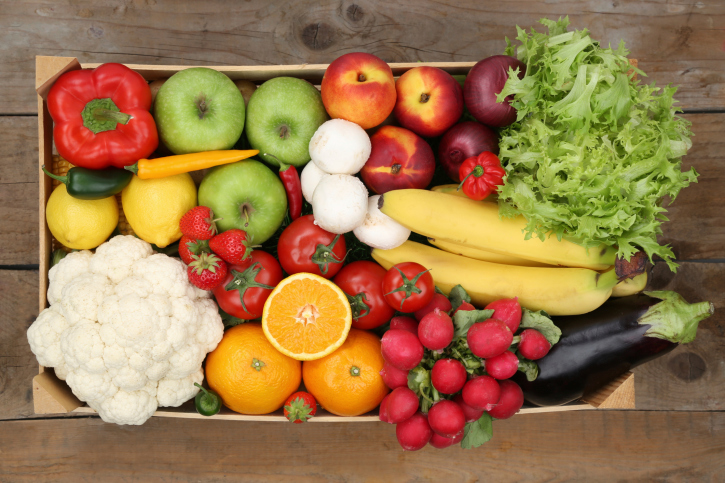Eating a diet rich in fruits and vegetables can provide you with many of the nutrients needed to maintain a healthy body. These foods are low in fat, high in fiber and full of vitamins. Incorporating a wide variety of fruits and vegetables can play an important role in reducing your risk for chronic diseases including heart disease, hypertension, and diabetes. It can also promote bone and immune system function and may reduce your risk for various cancers. And if that’s not enough, eating fruits and vegetables may also help with weight management, as they are low in calories but often help you feel fuller.
How many servings should I eat per day?
The general recommendation for fruits and vegetables is a minimum of 5 servings. For most people, the recommendations specify at least 2 servings of fruit per day and at least 3 servings of vegetables. Nevertheless, appropriate servings can vary depending on age, sex and activity level. If you’re interested in calculating your personal fruit and vegetable serving recommendation, check out this fruit and vegetable calculator.
What counts as a serving?
A serving of fruit equates to:
- 1 cup chopped fruit
- 8 ounces of 100 percent fruit juice
- ½ cup of dried fruit
- 1 medium sized piece of fruit
A serving of vegetables equals:
- 1 cup raw or cooked vegetable
- 8 ounces of 100 percent vegetable juice
- 2 cups of leafy greens
Need a visual of fruit and vegetable serving sizes? Check out this cheat sheet.
Are there any fruits and vegetables that are better than others?
We’re frequently exposed to stories and anecdotes of “super” fruits and vegetables, when the reality is they’re all good for you. When choosing fruits and vegetables, the best thing you can do to ensure a wide range of nutritional benefits is to “eat the rainbow.” The differences in the colors of fruit and vegetables are caused by nutrients that influence their pigmentation. Different colors signify different nutrients. For example, anthocyanins are the reason fruits and vegetables are red, purple and blue. Review this fruit and vegetable color list for more details on fruit and vegetable colors.
How can I eat more?
Try these tips to eat more fruits and vegetables:
- Salads are a great way to get a lot of colors at once. Aim for 5 colors in your salad such as spinach, shredded purple cabbage, carrots, tomatoes and mushrooms.
- Not a fan of salads? Give smoothies a try. They’re a great way to get multiple servings of fruits/vegetables. Check out delicious smoothie recipes here.
- Always have a bowl of fresh fruits on your kitchen counter—reach for one when you’re hungry for a snack!
- Stash non-perishable fruit and vegetable options in your desk at work, like dried fruit, fruit cups packaged in their own liquid or a can of 100 percent vegetable juice.
- Start your day with blueberries, bananas or strawberries in your cereal or oatmeal.
- Bring an apple, orange or banana as a snack to eat between your breakfast and lunch.
- Snack on broccoli, celery or carrots with low-fat dressing or hummus before dinner.
- Use fresh fruit as a healthy topping on frozen yogurt or ice cream.
- Rather than buying flavored yogurt, opt for the plain version and stir in your favorite fruit.
- Short on time? Frozen fruits and vegetables can be just as good for you as fresh. When fruits and vegetables are harvested, they begin to lose their nutrients. In some cases, frozen produce may actually have greater nutritional value—they are picked ripe and immediately frozen, which preserves their nutrients.
Looking for more nutrition guidance? If you’re a Health Advocate member with our Wellness Program, connect with a Wellness Coach for additional healthy eating tips.




[…] to eat a dark leafy green vegetable such as spinach, broccoli, kale, romaine, etc., three days each […]
[…] on healthy carbohydrates for energy. Opt for fruits, vegetables and whole grainsas your main sources of […]
[…] Yes, you do! Maintaining a diet high in fruits and vegetables has numerous health benefits. The easiest way to eat more fruits and vegetables is to have them make up half your plate at each meal. They can also be great healthy snack options. These low-fat, high-fiber foods can help you lose weight and get important vitamins and nutrients to keep you healthy. You can learn more about why you should eat fruits and vegetables here. […]
[…] on healthy carbohydrates for energy. Opt for fruits, vegetables and whole grains as your main sources of […]
[…] is common knowledge that eating fruits and vegetables is good for your health. But did you know that you can get greater nutritional benefit by eating a […]